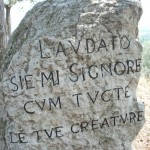“He descended into hell.”
I have my quibbles with a lot of the latest translation of the Roman Missal–especially, at the Vigil, the messing about with the texts for the baptismal rites that Deacon Greg Kandra points out–but I am delighted that the language of the Apostles’ Creed has returned to the old phrasing. It’s a reminder that in those hours between the Crucifixion and the Resurrection, when all creation waited in hushed stillness, Jesus himself wasn’t just waiting, just dead, just in some kind of suspended animation like Ripley aboard the Nostromo at the beginning of Aliens. No, according to tradition, he was gettin’ busy, opening a can of whoop-ass on the underworld. He was harrowing hell.
Jesus’ descent into hell is mentioned in the earliest creeds, although this was originally a way of saying that he experienced death as all humans did, and like them entered the abode of the dead. References in Scripture, though, gave inspiration to traditions that embellished the belief, until it was understood to mean that Jesus visited the land of the dead (Sheol, in Hebrew, Hades in Greek, Limbo to later Christians) to liberate righteous souls who had died before his coming. By the Middle Ages, especially in English theatre, this notion came to be seen as a full-out assault by Jesus and his angelic hosts against the forces of hell, a kind of Raid on Entebbe to ransom souls held hostage by Satan.
Outside of the stylized forms of Byzantine iconography, there are few really powerful artistic evocations of the moment of Resurrection. Maybe that’s because it’s just too large a truth for us to visualize–though American painter Robert Clark gave it a very big try with his ginormous Resurrection at Forest Lawn, which is part of a multimedia extravaganza unfolding several times daily at the cemetery parodied by Evelyn Waugh in The Loved One (also, I note in full disclosure, the cemetery where my parents and maternal grandfather await the resurrection of the dead). But Jesus’ descent into hell, his liberating siege, fires the imagination.
It’s known in art history as The Harrowing of Hell, from the Old English word that means to sack and pillage a besieged city. In the medieval mind, Jesus looted hell of its most prized possessions, the souls of the just. And he is sometimes depicted laying a hurt on the demonic troops as he does it.
Who are those just ones liberated in the harrowing? Dante, following the conventions of his time, excluded the pagan philosophers–even Virgil, his wise and noble guide–from the redeeming, leaving their shades to a Limbo that’s familiar from Homer. It’s not a place of punishment, but neither is it the fullness of bliss that is the beatific vision of the saved. Tradition and art name the ransomed as the righteous ones of biblical tradition. In Canto IV of the Inferno, this is what Dante learns:
“did any ever go—by his own merit
That astonishment is set to music in what is, for me, the high point of the Easter Vigil, the Exsultet. Even the somewhat clunky rerendering of the English text in the new Missal can’t diminish the power of this paradox, the felix culpa:
This is the night
when Christ broke the prison-bars of death
and rose victorious from the underworld.
Our birth would have been no gain
had we not been redeemed.
O wonder of your humble care for us!
O love, O charity beyond all telling,
to ransom a slave you gave away your Son!
O truly necessary sin of Adam,
destroyed completely by the Death of Christ!
O happy fault
that earned so great, so glorious a Redeemer!
O truly blessed night
worthy alone to know the time and hour
when Christ rose from the underworld!
Another definition of harrowing is agricultural: breaking up hardened soil to prepare it for seeding. At Easter, Christ harrows the hard ground of our hearts so that grace can be planted there . . . to rise.











